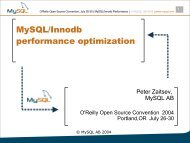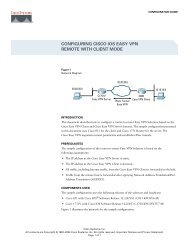OpenVPN Access Server System Administrator Guide
OpenVPN Access Server System Administrator Guide
OpenVPN Access Server System Administrator Guide
Create successful ePaper yourself
Turn your PDF publications into a flip-book with our unique Google optimized e-Paper software.
connection has been established, the browser window will show the connection status and list<br />
the address of the server the user is connected to along with the amount of data that has been<br />
transferred between the users client and the vpn server. The systray icon will also show the<br />
connection status and will display a status message informing the user they are connected after<br />
the connection has been established.<br />
2 <strong>OpenVPN</strong> <strong>Access</strong> <strong>Server</strong> Operation<br />
This section elaborates on some of the characteristics of <strong>OpenVPN</strong> <strong>Access</strong> <strong>Server</strong> deployments and<br />
further describes the operation of several components of the <strong>Access</strong> <strong>Server</strong>.<br />
2.1 Services and TCP/UDP Ports<br />
The <strong>OpenVPN</strong> <strong>Access</strong> <strong>Server</strong> provides three network services:<br />
Network Service TCP/UDP Default<br />
VPN <strong>Server</strong> TCP or UDP TCP port 443, if forwarding<br />
service for Connect Client<br />
Connect Client<br />
(HTTPS)<br />
Admin Web UI<br />
(HTTPS)<br />
<strong>OpenVPN</strong> <strong>Access</strong> <strong>Server</strong> <strong>System</strong> <strong>Administrator</strong> <strong>Guide</strong><br />
UDP port 1194<br />
TCP port 443 (via service forwarding)<br />
port 943 (direct)<br />
TCP port 443 (via service forwarding)<br />
port 943 (direct)<br />
Table 2 <strong>Access</strong> <strong>Server</strong> Services and Ports<br />
The VPN <strong>Server</strong> is the daemon that creates the VPN tunnels with VPN clients. If TCP is<br />
configured as the protocol for VPN <strong>Server</strong> communication, the VPN <strong>Server</strong> can also forward<br />
services to the Connect Client and/or Admin Web UI<br />
The Client Web Service is a secure Web service handling SSL-protected HTTP from Web<br />
browsers. Users log in to the Connect Client in order to download a pre-configured <strong>OpenVPN</strong><br />
Windows client installer file or a client configuration file. The normal port for such traffic is TCP<br />
port 443.<br />
The VPN Tunnel service can be configured to use either TCP or UDP. In the TCP case, it can also<br />
be configured to forward the Connect Client and/or Admin Web UI services. If service forwarding<br />
is used, only one TCP port needs to be made available to Internet clients. If applications requiring<br />
UDP communication (such as VoIP) are to be used over the VPN, configuring <strong>OpenVPN</strong> <strong>Access</strong><br />
<strong>Server</strong> to use UDP for VPN Tunneling will result in a the VPN tunnel communication being more<br />
efficient. In this case, the UDP port (number 1193, by default) on the server must also be made<br />
available to Internet clients.<br />
2.2 Typical Network Configurations<br />
The following sections describe the three most common supported network configurations used<br />
with <strong>OpenVPN</strong> <strong>Access</strong> <strong>Server</strong> deployments.<br />
5
















